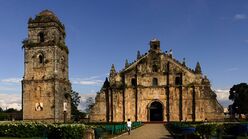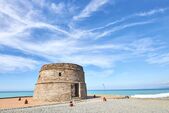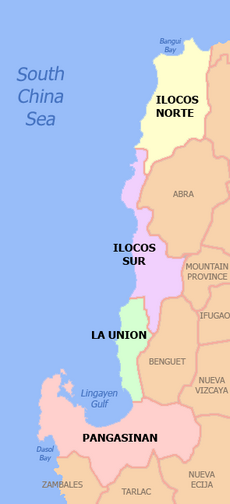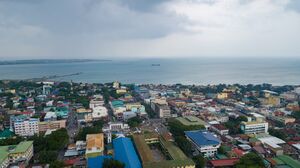منطقة إلوكوس
Ilocos
Sagor na Baybay na Luzon | |
|---|---|
| الموقع في الفلپين الموقع في الفلپين | |
| الإحداثيات: 16°37′N 120°19′E / 16.617°N 120.317°E | |
| البلد | |
| مجموعة الجزر | لوزون |
| Regional center | San Fernando (La Union) |
| Largest city | San Carlos (Pangasinan) |
| المساحة | |
| • الإجمالي | 13٬013٫60 كم² (5٬024٫58 ميل²) |
| أعلى منسوب | 2٬361 m (7٬746 ft) |
| التعداد (خطأ: زمن غير صحيح. تعداد السكان)[2] | |
| • الإجمالي | 948٬935، 1٬210٬909، 1٬459٬294، 1٬685٬564، 2٬042٬865، 2٬488٬391، 2٬726٬220، 2٬922٬892، 3٬550٬642، 3٬803٬890، 4٬200٬478، 4٬546٬789، 4٬748٬372، 5٬026٬128، 5٬301٬139 |
| • Estimate (2020) | 5٬220٬807[1] |
| منطقة التوقيت | UTC+8 (PST) |
| ISO 3166 code | PH-01 |
| Provinces | |
| Independent cities | 1
|
| Component cities | |
| Municipalities | 116 |
| Barangays | 3,267 |
| Cong. districts | 12 |
| Languages | |
| GDP (2023) | ₱814.29 billion $14.64 billion[3] |
| Growth rate | ▲ (7.1%)[3] |
| HDI | ▲ 0.743 (High) |
| HDI rank | 6th in the Philippines (2019) |
The Ilocos Region (Ilocano: Rehion/Deppaar ti Ilocos; Pangasinan: Sagor na Baybay na Luzon/Rehiyon Uno [the former literally translated to "west coast of Luzon"]; تگالوگ: Rehiyon ng Ilocos), designated as Region I, is an administrative region of the Philippines. Located in the northwestern section of Luzon, it is bordered by the Cordillera Administrative Region to the east, the Cagayan Valley to the northeast and southeast, Central Luzon to the south, and the South China Sea to the west.[5]
The region comprises four provinces (Ilocos Norte, Ilocos Sur, La Union, and Pangasinan) and one independent city (Dagupan). Its regional center is San Fernando, La Union, whereas the largest settlement is San Carlos, Pangasinan. The 2000 census reported that the major languages spoken in the region were Ilocano (64% of the total population at that time), Pangasinan (32.5%), and Tagalog and other languages (3.21%).[6]
. . . . . . . . . . . . . . . . . . . . . . . . . . . . . . . . . . . . . . . . . . . . . . . . . . . . . . . . . . . . . . . . . . . . . . . . . . . . . . . . . . . . . . . . . . . . . . . . . . . . . . . . . . . . . . . . . . . . . . . . . . . . . . . . . . . . . . . . . . . . . . . . . . . . . . . . . . . . . . . . . . . . . . . .
History
Prehistory
The region was first inhabited by the aboriginal Negritos, before they were pushed by successive waves of Austronesian immigrants that penetrated the narrow coast. Tingguians (Igorot) in the interior, Ilocanos in the north, Pangasinenses in the south, and Zambals in the southwesternmost areas settled the region.
Early history
As commercial trading routes became established in Southeast Asia, the pre-Hispanic Luyag na Caboloan (present-day Pangasinan) area in the vicinity of Lingayen gulf became maritime trading centers, as gold mined from the Cordillera Mountain Range came down along the Aringay-Tonglo-Balatok gold trail,[7][8] and was also traded in the neighboring settlement of Agoo, whose coast at the time was shaped in such a way that it was a good harbor for foreign vessels.[9][10]
Evidence of trade between the then-Pangasinense port of Agoo and China has been excavated in the form of porcelain and pottery pieces unearthed at the site of the Catholic church during its renovation, - which are now kept in the Museo de Iloko.[9] Japanese fishermen eventually established their first settlement in the Philippines there, passing on their fishing skills and technologies to the local populace.[9]
Spanish colonial era
The Spanish arrived in the 16th century and established Christian missions and governmental institutions to control the native population and convert them to Catholicism. Present-day Vigan in Ilocos Sur province became the diocesan seat of Nueva Segovia. By the end of the 1700s, Ilocos had 44,852 native families and 631 Spanish Filipino families.[11][12] It also had 10,041 Chinese Filipino families.[12] Ilocanos in the northern parts were less easily swayed, however, and remained an area filled with deep resentments against Spain. These resentments surfaced at various points in the Ilocos provinces' history as insurrections, most notably that of Andres Malong and Palaris of Pangasinan, Diego Silang and his wife Gabriela Silang in 1764, and the Basi Revolt in the 19th century.
However, it was the Pangasinans in the south who were the last to stand against the Spaniards.[13][مطلوب مصدر أفضل]
American invasion era
In 1901, the region came under American colonial rule, and in 1941, under Japanese occupation.
In 1901, towns of Nueva Ecija, namely Balungao, Rosales, San Quintin and Umingan were annexed to the province of Pangasinan. On November 30, 1903, several municipalities from northern Zambales including Agno, Alaminos, Anda, Bani, Bolinao, Burgos, Dasol, Infanta and Mabini were ceded to Pangasinan by the American colonial government. These municipalities were a part of the homeland of the Sambal people who wanted to remain within the Zambales province. This 1903 colonial decision has yet to be reverted.[14] The reason for transferring those towns from Nueva Ecija & Zambales to Pangasinan is because they were geographically further away from the capitals.
Japanese occupation era
During 1945, the combined American and the Philippine Commonwealth troops including with the Ilocano and Pangasinan guerillas liberated the Ilocos Region from Japanese forces during the Second World War.
The postwar era
The Ilocos region produced two presidents of the Republic of the Philippines within the first two decades after the recognition of Philippine independence: Elpidio Quirino and Ferdinand Marcos.
This period also marked a return of the tobacco industry to the Ilocos Region. Ever since the end of the tobacco monopoly, tobacco production had declined in the Ilocos as filipinos started shifting from locally made cigars to foreign made cigarettes.[15] But after reading a feature article series by Maximo Soliven which explained why Virginia tobacco would grow well on Ilocos soil, businessman Harry Stonehill was convinced to invest extensively in rebuilding the industry, establishing the Philippine Tobacco Flue-Curing and Redrying Corporation (PTFCRC) in 1951 and recruiting farmers from throughout Region 1 to produce tobacco.[16][17] The following year, La Union Congressman Manuel T. Cases filed a bill to "limit the importation of foreign leaf tobacco," which was eventually signed by President Elpidio Quirino as Republic Act 698.[18] This allowed Stonehill's investments to make a handsome profit,[19] and the newly-rebuilt local industry to bloom.[16] Stonehill was later deported a decade later, in the 1960s, for tax evasion and bribery of government officials, in what would later be called the Stonehill scandal,[19] but the tobacco industry continued to grow.[17][19]
The Martial Law era
Various human rights violations were documented in the Ilocos region during the Marcos martial law era, despite public perception that the region was supportive of Marcos' administration.[20] In Ilocos Norte, various farmers from the towns of Vintar, Dumalneg, Solsona, Marcos, and Piddig were documented to have been tortured,[20] and eight farmers in Bangui and three indigenous community members in Vintar were "salvaged" in 1984.[20]
Ilocanos who were critical of Marcos' authoritarian rule included Roman Catholic Archbishop and Agoo, La Union native Antonio L. Mabutas, who spoke actively against the torture and killings of church workers.[21][22] Other La Union natives who fought the dictatorship were student activists Romulo and Armando Palabay of San Fernando, La Union, whose torture and death in a military camp in Pampanga would lead them to being honored as martyrs in the fight against the dictatorship in the Philippines' Bantayog ng mga Bayani memorial.[23]
In Ilocos Norte, one of the prominent victims of the Martial Law era who came from Laoag was Catholic layperson and social worker Purificacion Pedro, who volunteered in organizations protesting the Chico River Dam Project in the nearby Cordillera Central mountains.[24] Wounded while visiting activist friends in Bataan, she was later killed by Marcos administration soldiers while recuperating in the hospital.[25][26] Another prominent opponent of the martial law regime was human rights advocate and Bombo Radyo Laoag program host David Bueno, who worked with the Free Legal Assistance Group in Ilocos Norte during the later part of the Marcos administration and the early part of the succeeding Aquino administration. He would later be assassinated by motorcycle-riding men in fatigue uniforms on October 22, 1987 – part of a wave of assassinations which coincided with the 1986-87 coup d'état which tried to unseat the democratic government set up after the 1986 People Power Revolution.[27] Both Bueno and Pedro were later honored among the first 65 people to have their names inscribed on the wall of remembrance of the Philippines' Bantayog ng mga Bayani, which honors the martyrs and heroes who fought the dictatorship,[28] and Pedro was listed among Filipino Catholics nominated to be named Servant of God.[29]
Integration of new provinces
The province of Pangasinan was transferred by Ferdinand Marcos from Region III into Region I in 1973 and afterwards imposed a migration policy for Ilokanos into Pangasinan, to the moderate detriment of the native Pangasinenses. Before the administration of Ferdinand Marcos, Pangasinan was not a part of the region.[30] He also included Abra, Mountain Province, and Benguet in the Ilocos region in a bid to expand Ilokano influence among the ethnic peoples of the Cordilleras.[31]
Transfer of provinces to the Cordillera Administrative Region
When the Cordillera Administrative Region was established in 1987 under Corazon Aquino, the indigenous provinces of Abra, Mountain Province, and Benguet were transferred into the newly formed region.
Contemporary history
The Ilocos region has produced two more Philippine Presidents in the years since the 1986 People Power revolution: Pangasinense Fidel V. Ramos and Ferdinand Marcos' son Bongbong Marcos.
The southern parts of the region were severely hit by the 1990 Luzon earthquake. Five municipalities in La Union were affected: Agoo, Aringay, Caba, Santo Tomas, and Tubao with a combined population of 132,208. Many buildings, including the Agoo Municipal hall,[32] the Museo de Iloko, the parish church of Aringay,[33] and the Basilica Minore of our Lady of Charity,[9] collapsed or were severely damaged. 100,000 families were displaced when two coastal villages sank due to liquefaction. The province suffered many casualties leaving 32 people dead. In Pangasinan, about 90 buildings in Dagupan were damaged, and about 20 collapsed. Some structures sustained damage because liquefaction caused buildings to sink as much as 1 metre (39 inches). The earthquake caused a decrease in the elevation of the city and several areas were flooded. The city suffered 64 casualties of which 47 survived and 17 died. Most injuries were sustained during stampedes at a university building and a theater.
. . . . . . . . . . . . . . . . . . . . . . . . . . . . . . . . . . . . . . . . . . . . . . . . . . . . . . . . . . . . . . . . . . . . . . . . . . . . . . . . . . . . . . . . . . . . . . . . . . . . . . . . . . . . . . . . . . . . . . . . . . . . . . . . . . . . . . . . . . . . . . . . . . . . . . . . . . . . . . . . . . . . . . . .
الجغرافيا
The Ilocos Region is divided into two contrasting geographical features. The Ilocos provinces occupy the narrow plain between the Cordillera Central mountain range and the South China Sea, whereas Pangasinan occupies the northwestern portion of the vast Central Luzon plain, having Zambales Mountains as its natural western limit.
Lingayen Gulf is the most notable body of water in Pangasinan and it contains several islands, including the Hundred Islands National Park. To the north of Ilocos is Luzon Strait.
The Agno River runs through Pangasinan from Benguet, flowing into a broad delta at the vicinities of Lingayen and Dagupan before emptying into Lingayen Gulf.
التقسيمات الإدارية
The Ilocos Region comprises 4 provinces, 1 independent component city, 8 component cities, 116 municipalities, and 3,265 barangays.[34]
المقاطعات
| المقاطعة | العاصمة | Population (2020)[35] | Area[36] | الكثافية | المدن | Muni. | Barangay | |||||
|---|---|---|---|---|---|---|---|---|---|---|---|---|
| كم² | sq mi | /كم² | /sq mi | |||||||||
| Laoag City | 11٫5% | 609٬588 | 3,418.75 | 1,319.99 | 180 | 470 | 2 | 21 | 559 | |||
| Vigan City | 13٫3% | 706٬009 | 2,596.00 | 1,002.32 | 270 | 700 | 2 | 32 | 768 | |||
| قالب:Country data La Union | San Fernando | 15٫5% | 822٬352 | 1,499.28 | 578.88 | 550 | 1,400 | 1 | 19 | 576 | ||
| Lingayen | 59٫7% | 3٬163٬190 | 5,450.59 | 2,104.48 | 580 | 1,500 | 4 | 44 | 1,364 | |||
| Total | 5,301,139 | 12,964.62 | 5,005.67 | 410 | 1,100 | 9 | 116 | 3,267 | ||||
|
• Figures for Pangasinan include the independent component city of Dagupan. | ||||||||||||
Governors and vice governors
| Province | Image | Governor | Political Party | Vice Governor | |
|---|---|---|---|---|---|

|
Matthew Marcos Manotoc | Nacionalista | Cecilia Araneta Marcos | ||
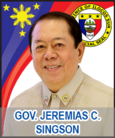
|
Jeremias C. Singson | NPC | Ryan Luis Singson | ||

|
Raphaelle Veronica Ortega-David | PDDS | Mario Eduardo Ortega | ||
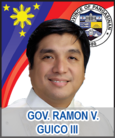
|
Ramon Guico III | Nacionalista | Mark Ronald DG. Lambino | ||
Cities and municipalities
- † Regional center
- ^ Independent City
| City/Municipality | Population (2020) | Area[37] | Density | Class | Income class | Province | ||
|---|---|---|---|---|---|---|---|---|
| Adams | 2,189 | 159.31 | 61.51 | 14 | 36 | Municipality | 5th | Ilocos Norte |
| Agno | 29,947 | 169.75 | 65.54 | 180 | 470 | Municipality | 3rd | Pangasinan |
| Agoo | 66,028 | 52.84 | 20.40 | [convert: invalid number] | Municipality | 1st | La Union | |
| Aguilar | 45,100 | 195.07 | 75.32 | 230 | 600 | Municipality | 3rd | Pangasinan |
| Alaminos | 99,397 | 164.26 | 63.42 | 610 | 1,600 | Component city | 4th | Pangasinan |
| Alcala | 48,908 | 45.71 | 17.65 | [convert: invalid number] | Municipality | 3rd | Pangasinan | |
| Alilem | 7,361 | 119.33 | 46.07 | 62 | 160 | Municipality | 4th | Ilocos Sur |
| Anda | 41,548 | 74.55 | 28.78 | 560 | 1,500 | Municipality | 3rd | Pangasinan |
| Aringay | 50,380 | 84.54 | 32.64 | 600 | 1,600 | Municipality | 2nd | La Union |
| Asingan | 57,811 | 66.64 | 25.73 | 870 | 2,300 | Municipality | 2nd | Pangasinan |
| Bacarra | 33,496 | 65.32 | 25.22 | 510 | 1,300 | Municipality | 3rd | Ilocos Norte |
| Bacnotan | 44,388 | 76.60 | 29.58 | 580 | 1,500 | Municipality | 1st | La Union |
| Badoc | 32,530 | 76.68 | 29.61 | 420 | 1,100 | Municipality | 2nd | Ilocos Norte |
| Bagulin | 14,428 | 107.33 | 41.44 | 130 | 340 | Municipality | 5th | La Union |
| Balaoan | 40,339 | 68.70 | 26.53 | 590 | 1,500 | Municipality | 1st | La Union |
| Balungao | 30,004 | 73.25 | 28.28 | 410 | 1,100 | Municipality | 4th | Pangasinan |
| Banayoyo | 7,931 | 24.63 | 9.51 | 320 | 830 | Municipality | 4th | Ilocos Sur |
| Bangar | 38,041 | 37.36 | 14.42 | [convert: invalid number] | Municipality | 3rd | La Union | |
| Bangui | 15,019 | 112.98 | 43.62 | 130 | 340 | Municipality | 4th | Ilocos Norte |
| Bani | 52,603 | 179.65 | 69.36 | 290 | 750 | Municipality | 2nd | Pangasinan |
| Banna | 19,297 | 92.73 | 35.80 | 210 | 540 | Municipality | 4th | Ilocos Norte |
| Bantay | 37,118 | 76.60 | 29.58 | 480 | 1,200 | Municipality | 1st | Ilocos Sur |
| Basista | 37,679 | 24.00 | 9.27 | [convert: invalid number] | Municipality | 4th | Pangasinan | |
| Batac | 55,484 | 161.06 | 62.19 | 340 | 880 | Component city | 5th | Ilocos Norte |
| Bauang | 78,449 | 73.15 | 28.24 | [convert: invalid number] | Municipality | 1st | La Union | |
| Bautista | 35,398 | 46.33 | 17.89 | 760 | 2,000 | Municipality | 4th | Pangasinan |
| Bayambang | 129,011 | 143.94 | 55.58 | 900 | 2,300 | Municipality | 1st | Pangasinan |
| Binalonan | 56,382 | 47.57 | 18.37 | [convert: invalid number] | Municipality | 1st | Pangasinan | |
| Binmaley | 86,881 | 118.50 | 45.75 | 730 | 1,900 | Municipality | 1st | Pangasinan |
| Bolinao | 83,979 | 197.22 | 76.15 | 430 | 1,100 | Municipality | 1st | Pangasinan |
| Bugallon | 74,962 | 189.64 | 73.22 | 400 | 1,000 | Municipality | 2nd | Pangasinan |
| Burgos | 10,759 | 128.90 | 49.77 | 83 | 210 | Municipality | 5th | Ilocos Norte |
| Burgos | 12,793 | 44.38 | 17.14 | 290 | 750 | Municipality | 4th | Ilocos Sur |
| Burgos | 9,006 | 70.80 | 27.34 | 130 | 340 | Municipality | 5th | La Union |
| Burgos | 23,749 | 131.32 | 50.70 | 180 | 470 | Municipality | 4th | Pangasinan |
| Caba | 23,119 | 46.31 | 17.88 | 500 | 1,300 | Municipality | 4th | La Union |
| Cabugao | 38,884 | 95.56 | 36.90 | 410 | 1,100 | Municipality | 1st | Ilocos Sur |
| Calasiao | 100,471 | 48.36 | 18.67 | [convert: invalid number] | Municipality | 1st | Pangasinan | |
| Candon | 61,432 | 103.28 | 39.88 | 590 | 1,500 | Component city | 4th | Ilocos Sur |
| Caoayan | 19,574 | 17.42 | 6.73 | [convert: invalid number] | Municipality | 4th | Ilocos Sur | |
| Carasi | 1,607 | 82.97 | 32.03 | 19 | 49 | Municipality | 5th | Ilocos Norte |
| Cervantes | 19,449 | 234.70 | 90.62 | 83 | 210 | Municipality | 4th | Ilocos Sur |
| Currimao | 12,215 | 34.08 | 13.16 | 360 | 930 | Municipality | 4th | Ilocos Norte |
| ^Dagupan | 174,302 | 44.47 | 17.17 | [convert: invalid number] | Independent component city | 2nd | Pangasinan | |
| Dasol | 31,355 | 166.60 | 64.32 | 190 | 490 | Municipality | 3rd | Pangasinan |
| Dingras | 40,127 | 96.00 | 37.07 | 420 | 1,100 | Municipality | 2nd | Ilocos Norte |
| Dumalneg | 3,087 | 88.48 | 34.16 | 35 | 91 | Municipality | 5th | Ilocos Norte |
| Galimuyod | 10,244 | 34.40 | 13.28 | 300 | 780 | Municipality | 4th | Ilocos Sur |
| Gregorio del Pilar | 4,472 | 41.66 | 16.09 | 110 | 280 | Municipality | 5th | Ilocos Sur |
| Infanta | 26,242 | 254.29 | 98.18 | 100 | 260 | Municipality | 3rd | Pangasinan |
| Labrador | 26,811 | 90.99 | 35.13 | 290 | 750 | Municipality | 4th | Pangasinan |
| Laoac | 34,128 | 40.50 | 15.64 | 840 | 2,200 | Municipality | 4th | Pangasinan |
| Laoag | 111,651 | 116.08 | 44.82 | 960 | 2,500 | Component city | 3rd | Ilocos Norte |
| Lidlidda | 4,705 | 33.84 | 13.07 | 140 | 360 | Municipality | 5th | Ilocos Sur |
| Lingayen | 107,728 | 62.76 | 24.23 | [convert: invalid number] | Municipality | 1st | Pangasinan | |
| Luna | 37,318 | 42.90 | 16.56 | 870 | 2,300 | Municipality | 3rd | La Union |
| Mabini | 26,454 | 291.01 | 112.36 | 91 | 240 | Municipality | 3rd | Pangasinan |
| Magsingal | 31,308 | 84.98 | 32.81 | 370 | 960 | Municipality | 3rd | Ilocos Sur |
| Malasiqui | 143,094 | 131.37 | 50.72 | [convert: invalid number] | Municipality | 1st | Pangasinan | |
| Manaoag | 76,045 | 55.95 | 21.60 | [convert: invalid number] | Municipality | 1st | Pangasinan | |
| Mangaldan | 113,185 | 48.47 | 18.71 | [convert: invalid number] | Municipality | 1st | Pangasinan | |
| Mangatarem | 79,323 | 317.50 | 122.59 | 250 | 650 | Municipality | 1st | Pangasinan |
| Mapandan | 38,058 | 30.00 | 11.58 | [convert: invalid number] | Municipality | 3rd | Pangasinan | |
| Marcos | 18,010 | 72.77 | 28.10 | 250 | 650 | Municipality | 4th | Ilocos Norte |
| Nagbukel | 5,465 | 43.12 | 16.65 | 130 | 340 | Municipality | 5th | Ilocos Sur |
| Naguilian | 52,189 | 104.60 | 40.39 | 500 | 1,300 | Municipality | 1st | La Union |
| Narvacan | 46,234 | 122.21 | 47.19 | 380 | 980 | Municipality | 2nd | Ilocos Sur |
| Natividad | 25,771 | 134.36 | 51.88 | 190 | 490 | Municipality | 4th | Pangasinan |
| Nueva Era | 11,968 | 515.02 | 198.85 | 23 | 60 | Municipality | 3rd | Ilocos Norte |
| Pagudpud | 25,098 | 194.90 | 75.25 | 130 | 340 | Municipality | 4th | Ilocos Norte |
| Paoay | 25,001 | 76.24 | 29.44 | 330 | 850 | Municipality | 4th | Ilocos Norte |
| Pasuquin | 29,678 | 210.54 | 81.29 | 140 | 360 | Municipality | 3rd | Ilocos Norte |
| Piddig | 22,475 | 216.20 | 83.48 | 100 | 260 | Municipality | 3rd | Ilocos Norte |
| Pinili | 17,626 | 89.48 | 34.55 | 200 | 520 | Municipality | 4th | Ilocos Norte |
| Pozorrubio | 74,729 | 134.60 | 51.97 | 560 | 1,500 | Municipality | 1st | Pangasinan |
| Pugo | 19,337 | 62.84 | 24.26 | 310 | 800 | Municipality | 5th | La Union |
| Quirino | 9,306 | 240.10 | 92.70 | 39 | 100 | Municipality | 4th | Ilocos Sur |
| Rosales | 66,711 | 66.39 | 25.63 | [convert: invalid number] | Municipality | 1st | Pangasinan | |
| Rosario | 60,278 | 73.98 | 28.56 | 810 | 2,100 | Municipality | 1st | La Union |
| Salcedo | 11,110 | 103.44 | 39.94 | 110 | 280 | Municipality | 4th | Ilocos Sur |
| San Carlos | 205,424 | 169.03 | 65.26 | [convert: invalid number] | Component city | 3rd | Pangasinan | |
| San Emilio | 7,206 | 141.44 | 54.61 | 51 | 130 | Municipality | 4th | Ilocos Sur |
| San Esteban | 8,381 | 19.62 | 7.58 | 430 | 1,100 | Municipality | 5th | Ilocos Sur |
| San Fabian | 87,428 | 81.28 | 31.38 | [convert: invalid number] | Municipality | 1st | Pangasinan | |
| † San Fernando | 125,640 | 102.72 | 39.66 | [convert: invalid number] | Component city | 3rd | La Union | |
| San Gabriel | 18,943 | 129.87 | 50.14 | 150 | 390 | Municipality | 4th | La Union |
| San Ildefonso | 8,190 | 11.35 | 4.38 | 720 | 1,900 | Municipality | 5th | Ilocos Sur |
| San Jacinto | 44,351 | 44.18 | 17.06 | [convert: invalid number] | Municipality | 3rd | Pangasinan | |
| San Juan | 26,674 | 64.37 | 24.85 | 410 | 1,100 | Municipality | 3rd | Ilocos Sur |
| San Juan | 40,507 | 57.12 | 22.05 | 710 | 1,800 | Municipality | 2nd | La Union |
| San Manuel | 54,271 | 129.18 | 49.88 | 420 | 1,100 | Municipality | 1st | Pangasinan |
| San Nicolas | 38,895 | 40.18 | 15.51 | 970 | 2,500 | Municipality | 2nd | Ilocos Norte |
| San Nicolas | 39,778 | 210.20 | 81.16 | 190 | 490 | Municipality | 1st | Pangasinan |
| San Quintin | 33,980 | 115.90 | 44.75 | 290 | 750 | Municipality | 3rd | Pangasinan |
| San Vicente | 13,118 | 12.60 | 4.86 | [convert: invalid number] | Municipality | 5th | Ilocos Sur | |
| Santa | 14,992 | 109.10 | 42.12 | 140 | 360 | Municipality | 4th | Ilocos Sur |
| Santa Barbara | 92,187 | 61.37 | 23.70 | [convert: invalid number] | Municipality | 1st | Pangasinan | |
| Santa Catalina | 14,493 | 9.68 | 3.74 | [convert: invalid number] | Municipality | 5th | Ilocos Sur | |
| Santa Cruz | 41,366 | 88.78 | 34.28 | 470 | 1,200 | Municipality | 1st | Ilocos Sur |
| Santa Lucia | 25,966 | 49.72 | 19.20 | 520 | 1,300 | Municipality | 3rd | Ilocos Sur |
| Santa Maria | 30,006 | 63.31 | 24.44 | 470 | 1,200 | Municipality | 3rd | Ilocos Sur |
| Santa Maria | 34,220 | 69.50 | 26.83 | 490 | 1,300 | Municipality | 4th | Pangasinan |
| Santiago | 19,471 | 46.36 | 17.90 | 420 | 1,100 | Municipality | 4th | Ilocos Sur |
| Santo Domingo | 29,041 | 55.49 | 21.42 | 520 | 1,300 | Municipality | 3rd | Ilocos Sur |
| Santo Tomas | 40,846 | 64.00 | 24.71 | 640 | 1,700 | Municipality | 4th | La Union |
| Santo Tomas | 14,878 | 12.99 | 5.02 | [convert: invalid number] | Municipality | 5th | Pangasinan | |
| Santol | 14,166 | 93.70 | 36.18 | 150 | 390 | Municipality | 4th | La Union |
| Sarrat | 25,186 | 57.39 | 22.16 | 440 | 1,100 | Municipality | 1st | Ilocos Norte |
| Sigay | 2,552 | 81.55 | 31.49 | 31 | 80 | Municipality | 5th | Ilocos Sur |
| Sinait | 25,998 | 65.56 | 25.31 | 400 | 1,000 | Municipality | 3rd | Ilocos Sur |
| Sison | 52,320 | 81.88 | 31.61 | 640 | 1,700 | Municipality | 3rd | Pangasinan |
| Solsona | 24,851 | 166.23 | 64.18 | 150 | 390 | Municipality | 3rd | Ilocos Norte |
| Sual | 39,091 | 130.16 | 50.26 | 300 | 780 | Municipality | 1st | Pangasinan |
| Sudipen | 17,187 | 97.59 | 37.68 | 180 | 470 | Municipality | 4th | La Union |
| Sugpon | 4,930 | 57.11 | 22.05 | 86 | 220 | Municipality | 5th | Ilocos Sur |
| Suyo | 10,766 | 124.00 | 47.88 | 87 | 230 | Municipality | 4th | Ilocos Sur |
| Tagudin | 41,538 | 151.19 | 58.37 | 270 | 700 | Municipality | 2nd | Ilocos Sur |
| Tayug | 45,241 | 51.24 | 19.78 | 880 | 2,300 | Municipality | 3rd | Pangasinan |
| Tubao | 31,763 | 50.75 | 19.59 | 630 | 1,600 | Municipality | 4th | La Union |
| Umingan | 77,074 | 258.43 | 99.78 | 300 | 780 | Municipality | 1st | Pangasinan |
| Urbiztondo | 55,557 | 81.80 | 31.58 | 680 | 1,800 | Municipality | 3rd | Pangasinan |
| Urdaneta | 144,577 | 100.26 | 38.71 | [convert: invalid number] | Component city | 2nd | Pangasinan | |
| Vigan | 53,935 | 25.12 | 9.70 | [convert: invalid number] | Component city | 4th | Ilocos Sur | |
| Villasis | 65,047 | 75.83 | 29.28 | 860 | 2,200 | Municipality | 1st | Pangasinan |
| Vintar | 33,339 | 614.35 | 237.20 | 54 | 140 | Municipality | 1st | Ilocos Norte |
. . . . . . . . . . . . . . . . . . . . . . . . . . . . . . . . . . . . . . . . . . . . . . . . . . . . . . . . . . . . . . . . . . . . . . . . . . . . . . . . . . . . . . . . . . . . . . . . . . . . . . . . . . . . . . . . . . . . . . . . . . . . . . . . . . . . . . . . . . . . . . . . . . . . . . . . . . . . . . . . . . . . . . . .
Economy
Poverty incidence of
|
Although the economy in the southern portion of the region, especially Pangasinan, is anchored on aquaculture, agro-industrial and service industry akin to its Central Luzon neighbor, the economy in the northern portion of the region is anchored in the agricultural sector. The economy in Pangasinan is driven by agro-industrial (particularly in inland towns) and aquaculture (in coastal areas) businesses, such as milkfish (bangus) cultivation and processing, livestock raising, fish paste processing (bagoong), and others. Income in the Ilocos provinces or northern portion mostly come from cultivating rice, tobacco, corn, sugarcane, and fruits; raising livestock such as pigs, chicken, goats, and carabaos (water buffalos).
The distribution of the economic activity in the region may be seen from the collection of tax revenue of the national government. The bulk of the collections come from Pangasinan, which posted 61% of the total.[39]
The service and light manufacturing industries are concentrated in the cities. Dagupan, a major financial, commercial and educational hub in the north, is mostly driven by its local entrepreneurs, which have expanded its network up to the national level such as the CSI Group, Magic Group, BHF Group, Guanzon Group, St Joseph Drugs, and Siapno-Tada Optical, among others. San Fernando in La Union also has an international shipping port and the upgraded San Fernando Airport. While Laoag in Ilocos Norte has an international airport.[بحاجة لمصدر]
The tourism industry, driven by local airlines and land transportation firms in the area like Pangasinan Solid North Bus, Dagupan Bus Company, Farinas Transit Company and Partas, focuses on the coastal beaches and on eco-tourism. There are fine sands stretching along Lingayen Gulf area notably the historic Tondaligan Beach in Dagupan and the rest of the region's coastal areas.[بحاجة لمصدر]
Additionally, the Ilocanos are known for their dark-colored clay burnay pottery and blanket weaving.[40]
Demographics
| Year | Pop. | ±% p.a. |
|---|---|---|
| Source: Philippine Statistics Authority[41] | ||
Ethnicity
The Ilocos provinces are the historical homeland of the Ilocanos. In the 2000 Census, the Ilocanos comprised 64% of the region, Pangasinan people 32.5%, and the Tagalogs 3%.[6]
Pangasinan is the historical homeland of the Pangasinans. The population of Pangasinan comprises approximately 60% of the total population of the region. The Ilocanos started migrating to Pangasinan in the 19th century.[42] Pangasinan was formerly a province of Region III (Central Luzon) before President Marcos signed Presidential Decree No. 1, 1972, incorporating it into Region I. Part of the historical homeland of Pangasinans in Ilocos Region is south La Union. Minority groups include the Tingguian and Isneg communities that inhabit the foothills of the Cordillera mountains, and Sambals who settle in west Pangasinan, part of the historical homeland of the Sambals. The few Tagalogs mostly live in southeast Pangasinan bordering Tagalog-speaking Nueva Ecija, mostly descendants of settlers from Nueva Ecija itself, with the rest from Bulacan and Aurora. Other minority groups not native in the region include Maguindanaons, Maranaos, Tausugs, Kapampangans, Cebuanos, Hiligaynons and foreigners and their Filipino-born descendants such as Chinese[43]and Indians.[44]
Language
Ilocano is the main language of the majority in the region, with La Union recognizing it as an official language since 2012.[45] It is also spoken in neighboring regions of Cagayan Valley (Region II), Cordillera Administrative Region and parts of Central Luzon (Region III) as the lingua franca among Ilocano and non-Ilocano residents. Ilocano is also recognized as a minority language in Mindoro, Palawan, and Mindanao (particularly in some areas in Soccsksargen), where Ilocanos had have been significant residents since the early 20th century. It is the third most widely spoken language in the Philippines, estimating 11 million speakers as of 2022. The language has many speakers overseas, including the American states of California and Hawaii.[46]
Another major regional Philippine language spoken in the region is Pangasinan (a native language in the eponymous Pangasinan province among the ethnic group of the same name). It is the official and the indigenous language of Pangasinan and is the most spoken language in the region's highly urbanized area, Central Pangasinan. Spoken natively in urban centers such as Dagupan, Lingayen, San Carlos, among others. Native speakers can also be found in nearby Tarlac, La Union and Benguet. Significant provincial languages such as Bolinao and Sambal languages in western Pangasinan, and Cordilleran languages (near the borders of the Cordillera Administrative Region) are spoken in the region. Tagalog is spoken by residents in towns along the border with Nueva Ecija, and its standard dialect Filipino and English are also spoken and understood in the region, utilized in business, education and media.
Languages not native in the region are also spoken there such as Maranao, Maguindanaon, Tausug, Kapampangan (which Bolinao & Sambal languages are related to), Cebuano and Hiligaynon to varying degrees by their respective ethnic communities within the region.
Religion
The population is predominantly Roman Catholic with strong adherents of Protestantism such as the Aglipayan denomination further north of the country where it is originated. There are also adherents to other religions, such as Iglesia ni Cristomakes up 3rd largest religion in the Region has 10 ecclesiastical districts in 4 provinces comprising 5-6% adherents , Mormons, and the like. There is also an undercurrent of traditional animistic beliefs especially in rural areas. Islam is a significant minority religion in the region especially in some urban areas adhered by minority Maranaos and other Moro communities, with some former Christian Ilocanos converted to that religion either by study abroad or contact with Moro migrants from the southern Philippines. The small mercantile Chinese and Indian communities are primarily Buddhists, Taoists, Hindus, Jains and Sikhs.[بحاجة لمصدر]
Culture and the arts
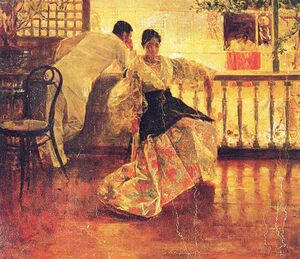
The Ilocos region is noted for its distinctive culture, shaped by the austere demands of its geography.[47]
The region has given birth to numerous artists who have won national acclaim - among the most notable being writer and activist Isabelo de los Reyes of Vigan who helped publish the earliest currently-extant text of Biag ni Lam-Ang; Badoc-born Philippine Revolution era activist and leader Juan Luna; and Binalonan-born Carlos Bulosan, whose novel America is in the Heart has become regarded as "[t]he premier text of the Filipino-American experience."[48]
The region is also home to several National Artists of the Philippines, including National Artist for Theater Severino Montano who was conferred the honor in 2001,[49] and National Artist for Dance Lucrecia Kasilag, who was conferred the honor in 1989.
In contemporary arts, The Galila Arts Festival, which features Pangasinense artists and tourist spots in the fourth district of Pangasinan, was inaugurated in 2023. Aside from encouraging arts in the province, the festival also aims to attract tourists.[50]
Notable people
- Elpidio Quirino, sixth President of the Philippines
- Ferdinand Marcos, tenth President of the Philippines
- Fidel V. Ramos, twelfth President of the Philippines, from Pangasinan
- Bongbong Marcos, seventeenth President of the Philippines
- Mariano Marcos, Former Congressman of the 2nd district of Ilocos Norte and Commonly known as father of Ferdinand Marcos, who was President of the Philippines from 1965 to 1986, and the grandfather of current senator Imee Marcos and the current 17th Philippine president Bongbong Marcos.
- Gregorio Aglipay, founder of the Aglipayan Church, he is from Batac, Ilocos Norte
- Manuel Arguilla, writer, patriot, and martyr during the Japanese occupation
- Salvador Bernal, his output included over 300 productions in art, film and music, and earned him the award of National Artist for Theater and Design in 2003, from Dagupan
- Gloria Diaz, Philippines- first Miss Universe from Aringay, La Union
- Victorio Edades, Father of Modern Philippine Painting. A National Artist awardee for Visual Arts (Painting) He hailed from Dagupan
- Josefa Llanes Escoda, founder of Girl Scouts of the Philippines, from Dingras, Ilocos Norte.
- Lucrecia Roces Kasilag – National Artist of the Philippines for Music, from San Fernando, La Union
- Juan Luna, famous Filipino painter of the Spoliarium from Badoc, Ilocos Norte
- Antonio Luna, army general who fought in the Philippine–American War, He is from Badoc, Ilocos Norte.
- Antonio Mabutas – Agoo-born first bishop of Diocese of Laoag and the second Archbishop of the Archdiocese of Davao, historically noted as the first Roman Catholic Archbishop to write a pastoral letter to criticize human rights violations under the Marcos dictatorship.[21][22]
- Bienvenido Nebres – Bacnotan-raised academic, National Scientist of the Philippines for Mathematics, former Provincial Superior of the Society of Jesus in the Philippines
- Armando "Mandrake" Ducusin Palabay - Filipino student leader and activist from San Fernando La Union, honored at the Philippines' Bantayog ng mga Bayani as a martyr of the resistance against the Marcos dictatorship.[23][51]
- Orlando Quevedo, cardinal and third Archbishop of the Archdiocese of Cotabato. First cardinal from Mindanao. Born and spent his early childhood in Laoag, Ilocos Norte, he had been a resident in Marbel, South Cotabato until he graduated high school.
- Artemio Ricarte, Filipino general during the Philippine Revolution and the Philippine–American War
- Diego Silang, male revolutionary leader during the Spanish Occupation
- Gabriela Silang, female revolutionary leader during the Spanish Occupation
- Teofilo Yldefonso, The first Filipino and Southeast Asian to win an Olympic medal and the only male Filipino olympian to win multiple medals. He is from Piddig, Ilocos Norte.
See also
References
- ^ "POPULATION PROJECTIONS BY REGION, PROVINCE, CITIES AND MUNICIPALITIES, 2020-2025". www.doh.gov.ph. Department of Health. August 27, 2020. Archived from the original on May 14, 2021. Retrieved October 16, 2020.
- ^
Census of Population (2015). Highlights of the Philippine Population 2015 Census of Population. PSA. Retrieved 20 يونيو 2016.
{{cite encyclopedia}}: Cite has empty unknown parameter:|chapterurl=(help)CS1 maint: numeric names: authors list (link) - ^ أ ب "Tables | Philippine Statistics Authority | Republic of the Philippines". Philippine Statistics Authority. Retrieved April 26, 2024.
- ^ "Sub-national HDI – Area Database – Global Data Lab". hdi.globaldatalab.org. Archived from the original on September 23, 2018. Retrieved March 13, 2020.
- ^ "Overview of the Region | DepEd RO1". Archived from the original on 2021-09-15. Retrieved 2021-09-15.
- ^ أ ب "Ilocos Region: To Reach Five Millionth Mark in Nine Years (Results from the 2000 Census of Population and Housing, NSO); Table 8. Language/Dialect Generally Spoken in the Households: Ilocos Region, 2000". Philippine Statistics Authority. January 31, 2003. Archived from the original on April 28, 2003. Retrieved March 29, 2016.
- ^ Panela, Shaira (2017-03-19). "Looking into the past through the eyes of the future". Rappler (in الإنجليزية الأمريكية). Archived from the original on 2022-01-03. Retrieved 2022-01-03.
- ^ Scott, William (1974). The Discovery of the Igorots. Quezon City: New Day Publishers. p. 58. ISBN 9711000873.
- ^ أ ب ت ث Sals, Florent Joseph (2005). The History of Agoo: 1578-2005 (in الإنجليزية). La Union: Limbagan Printhouse. p. 80.
- ^ Mendoza-Cortes, Rosario (1974). Pangasinan, 1572-1800. Quezon City: University of the Philippines Press.
- ^ "ESTADISMO DE LAS ISLAS FILIPINAS TOMO PRIMERO By Joaquín Martínez de Zúñiga (Original Spanish)" (PDF). Archived (PDF) from the original on 2016-03-09. Retrieved 2024-02-23.
- ^ أ ب ESTADISMO DE LAS ISLAS FILIPINAS TOMO SEGUNDO By Joaquín Martínez de Zúñiga (Original Spanish)
- ^ Culture and History by Nick Joaquin
- ^ Bautista, Joseph (January 2018). "Agno Rustic Pangasinan 0". The Manila Times. Archived from the original on May 2, 2018. Retrieved May 2, 2018.
- ^ Sison, Norman. "Tabacalera: 130 years of cigars and Philippine history". The Philippine Star. Archived from the original on 2023-10-28. Retrieved 2024-03-26.
- ^ أ ب Department of Agriculture, National Tobacco Administration. "Tobacco History". National Tobacco Administration (in الإنجليزية الأمريكية). Retrieved 2024-03-26.
- ^ أ ب "Archived copy". Archived from the original on 2022-04-23. Retrieved 2024-03-30.
{{cite web}}: CS1 maint: archived copy as title (link) - ^ "The American Chamber of Commerce Journal, June 1951". The American Chamber of Commerce Journal. XXVII (6). June 1951. Archived from the original on 2024-03-30.
- ^ أ ب ت Magno, Alexander R., ed. (1998). "A Web of Corruption". Kasaysayan, The Story of the Filipino People Volume 9:A Nation Reborn. Hong Kong: Asia Publishing Company Limited.
- ^ أ ب ت "Ilocanos remember dark days of martial law, vow to continue fight". October 2, 2012. Archived from the original on September 15, 2021. Retrieved September 15, 2021.
- ^ أ ب "Honoring Davao's Contributions to the Struggle for Rights, Freedom". Bantayog ng mga Bayani. February 23, 2018. Archived from the original on 2018-02-28. Retrieved 8 February 2020.
- ^ أ ب Maglana, MAgz (2017-07-10). "VOICES FROM MINDANAO: Fear is not a good foundation for getting Mindanao out of the rut". MindaNews. Archived from the original on 2020-02-08. Retrieved 8 February 2020.
- ^ أ ب "PALABAY, Armando D. – Bantayog ng mga Bayani". bantayog.org. January 18, 2017. Archived from the original on January 11, 2020. Retrieved 2020-01-22.
- ^ "MARTYRS & HEROES: PEDRO, Purificacion A." July 13, 2016. Archived from the original on October 30, 2020. Retrieved November 13, 2021.
- ^ Remollino, Alexander Martin (December 14–20, 2003). "Human Rights Martyrs of the Word". www.bulatlat.com. Archived from the original on 2004-03-12.
- ^ "No Way to Go But Onwards! Philippine Religious Resist Marcos Repression" (PDF). Christian Conference of Asia: CCA News. Christian Conference of Asia. 18 (3): 4. March 1983. Archived from the original on 2021-11-13. Retrieved 2021-11-13.
- ^ Clarke, Gerard (2006). The Politics of NGOs in Southeast Asia. Routledge.
- ^ "A Tribute to Human Rights Lawyer David Bueno (1988)". August 19, 2015. Archived from the original on May 23, 2022. Retrieved October 31, 2021.
- ^ "Philippines". newsaints.faithweb.com. Archived from the original on 2019-10-09.
- ^ "Presidential Decree No. 1, s. 1972". September 24, 1972. Archived from the original on September 28, 2022. Retrieved May 27, 2019.
- ^ "Presidential Decree No. 224, s. 1973". June 22, 1973. Archived from the original on May 27, 2019. Retrieved November 5, 2016.
- ^ "23 Years in La Union". The Philippine Navigators (in الإنجليزية الأمريكية). 2015-12-12. Archived from the original on 2020-07-16. Retrieved 2020-07-16.
- ^ "Aringay through the years". Archived from the original on 2024-05-07. Retrieved 2024-05-06.
- ^ "List of Regions". National Statistical Coordination Board. Archived from the original on October 13, 2008. Retrieved January 9, 2011.
- ^ "POPULATION PROJECTIONS BY REGION, PROVINCE, CITIES AND MUNICIPALITIES, 2020-2025". www.doh.gov.ph. Department of Health. August 27, 2020. Archived from the original on May 14, 2021. Retrieved October 16, 2020.
- ^ "PSGC Interactive; List of Provinces". Philippine Statistics Authority. Archived from the original on January 11, 2013. Retrieved March 30, 2016.
- ^ "PSGC Interactive; List of Cities". Philippine Statistics Authority. Archived from the original on April 29, 2011. Retrieved March 29, 2016.
- ^ "Poverty incidence (PI):". Philippine Statistics Authority. Retrieved December 28, 2020.
- ^ "National Statistical Coordination Board". Archived from the original on June 14, 2006. Retrieved July 2, 2006.
- ^ "Region 1 - Profile". Department of Trade and Industry Philippines. Archived from the original on 2021-02-09. Retrieved 2024-07-14.
- ^ "Population and Annual Growth Rates for The Philippines and Its Regions, Provinces, and Highly Urbanized Cities" (PDF). 2010 Census and Housing Population. Philippine Statistics Authority. Archived from the original (PDF) on September 28, 2013. Retrieved August 9, 2013.
- ^ Rosario Mendoza Cortes, Pangasinan, 1801–1900: The Beginnings of Modernization
- ^ "Chen Laiping met the Fil-Chinese community in Vigan and visites University of Northern Philippines". laoag.china-consulate.gov.cn. Archived from the original on 2022-05-16. Retrieved 2023-09-23.
- ^ "Indian businesses explore opportunities in Ilocos Norte". The Manila Times (in الإنجليزية). 2023-04-04. Archived from the original on 2023-10-08. Retrieved 2023-09-23.
- ^ Elias, Jun. "Iloko La Union's official language". Philstar.com. Retrieved 2023-09-23.
- ^ Webster (2022-04-30). "Language of the Month April 2022: Ilocano". The National Museum of Language (in الإنجليزية الأمريكية). Retrieved 2023-09-23.
- ^ Fernandez, Doreen (2020). Tikim : essays on Philippine food and culture. Leiden ; Boston. ISBN 978-90-04-41479-2. OCLC 1114270889. Archived from the original on 2024-07-14. Retrieved 2021-11-13.
{{cite book}}: CS1 maint: location missing publisher (link) - ^ "America Is in the Heart: A Personal History" by Carlos Bulosan (Introduction by Carey McWilliams) Archived 2010-08-23 at the Wayback Machine, University of Washington Press, washington.edu
- ^ "About Culture and Arts". www.ncca.gov.ph. Archived from the original on 28 September 2007. Retrieved 11 January 2022.
- ^ "Arts, culture, tourism converge for Pangasinan's Galila Arts Fest". Philippine News Agency. Archived from the original on 2024-03-02. Retrieved 2023-11-02.
- ^ Armando Palabay (YouTube Video). Commission on Human Rights of the Philippines. Archived from the original on 2021-12-12.
External links
 Media related to منطقة إلوكوس at Wikimedia Commons
Media related to منطقة إلوكوس at Wikimedia Commons- قالب:Wikivoyage inline
 Geographic data related to منطقة إلوكوس at OpenStreetMap
Geographic data related to منطقة إلوكوس at OpenStreetMap
- CS1 maint: numeric names: authors list
- CS1 الإنجليزية الأمريكية-language sources (en-us)
- CS1 maint: location missing publisher
- Short description is different from Wikidata
- Articles with hatnote templates targeting a nonexistent page
- Missing redirects
- Pages using multiple image with auto scaled images
- Pages using gadget WikiMiniAtlas
- Articles containing Ilocano-language text
- Pages using Lang-xx templates
- Articles containing Pangasinan-language text
- Articles containing تگالوگ-language text
- كل المقالات بدون مراجع موثوقة
- كل المقالات بدون مراجع موثوقة from May 2019
- Convert errors
- Articles with unsourced statements from January 2023
- Articles with unsourced statements from September 2007
- Ilocos Region
- Regions of the Philippines
- Luzon
- صفحات مع الخرائط
